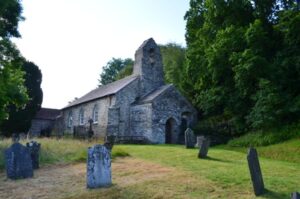Carregwen is a hamlet located in the parish of Manordeifi and lies on the northern edge of the county of Pembrokeshire, in the Hundred of Kilgerran, bordered by the River Teifi. The parish is rural and incorporates the villages of Newchapel and Abercych, a small village which lies along the western side of the Cych valley. The River Cych runs into the River Teifi on the outskirts of the village. The Church contains several war memorials: in November 1915 a stained glass window was unveiled and dedicated to Major Lawrence Robert Vaughan Colby, and a marble tablet was also unveiled there by the Archbishop of St. David’s in October 1915 to commemorate Major Colby. The Church also contains a brass memorial plaque, which is identical to one located within Abercych Memorial Hall, which was erected to commemorate the men of Manordeifi who served and died during the Great War. The photographs of the memorials have been kindly sent in by Ray Jones.
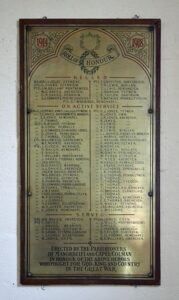
The Great War, 1914-1918
John William Bellamy, Private, 116552, Machine Gun Corps. John was born in Boston, Lincolnshire in 1898, the son of Frederick William Bellamy and Rebecca Bellamy. By 1911 the family was residing at Cilgwyn, Boncath, where Frederick worked as a Gamekeeper. John enlisted at Carmarthen into the South Wales Borderers, with the Service Number 202014, but after training was transferred into the 9th Company, Machine Gun Corps. He was probably posted to France during the summer of 1917, where his Company was attached to 9 Brigade, 3rd Division. The Division had been in France since the outbreak of war, and John joined his unit at Ypres. The division fought in the Third Battle of Ypres, at the Battle of the Menin Road and the Battle of Polygon Wood. In November the Division moved south, and fought at the Battle of Cambrai. It was still in the area on 21 March 1918 when the German Spring Offensive swept through the British lines, and took part in heavy fighting over the coming days. The battered Division was moved to Flanders to rebuild, but the Germans switched the focus of their offensive to Flanders and the Division was caught up in heavy fighting again in the Lys valley. John was killed in action during the Battle of Kemmel on 25 April 1918, aged 20. He has no known grave, and is commemorated on the Tyne Cot Memorial, Belgium.
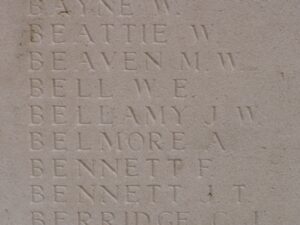
Lawrence Robert Vaughan Colby, Major, Grenadier Guards. Lawrence was born on 3 April 1880, the only son of John Vaughan Colby and of Anne Harriet Colby, of Ffynone, Manordeifi. Lawrence was a pre-war regular in the Army, and had seen service during the Boer War of 1899-1901. By the outbreak of the Great War he was serving as a Major with the 1st Battalion, Grenadier Guards, which was attached to 20 Brigade, 7th Division. The Division was formed during September 1914 and landed at Zeebrugge on 6 October 1914. The City was already falling however, and so the Division was moved to Ypres, where it became the first British Division to hold the city. They fought during the First Battle of Ypres, and helped stop the German advance through Belgium. Lawrence was sadly killed in action at Ypres on 24 October 1914. He was 34 years old, and has no known grave, and so is remembered on the Ypres (Menin Gate) Memorial, Belgium.
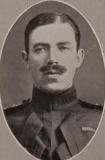
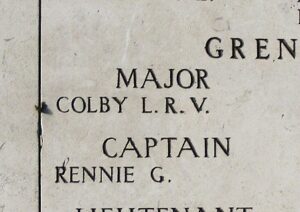
Gwilym Rees Davies, Private, 228274, South Wales Borderers. Gwilym was the son of William and Rachel Davies, of Penrhiw, Pontselly, Abercych. He worked as a Shoeing Smith prior to the war and lived at Blaenfforest, Cardiff Road, Treforest. He enlisted at Pontypridd on 10 December 1915 into the Monmouthshire Regiment and was posted to France on 24 February 1917, joining the 11th Battalion, South Wales Borderers, which was attached to 115 Brigade, 38th (Welsh) Division. The division was in position along the canal bank at Boesinghe, north of Ypres, and on 31 July 1917 launched its famous assault on Pilckem Ridge. A note on Gwilym’s service papers shows that he was declared killed in action at Pilckem Ridge that day, but he was not and rejoined the battalion. On 27 February 1918 the battalion was disbanded, and its members were shared between other units. Gwilym was among a large number of men posted to a new unit, the 2nd Entrenching Battalion, which moved to positions around Westhoek Ridge. On 11 April 1918, two days after the German attack on the Lys was launched, the 2nd Entrenching Battalion was caught up in heavy fighting around Meteren. Gwilym was killed in action during the heavy fighting that day. He was 29 years old when he was killed that day and is commemorated on the Arras Memorial, France. He is also commemorated on his parents’ grave at Bryn Sion Chapel, Abercych.
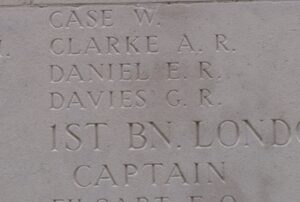
William George Davies, Private, 204710, Royal Welsh Fusiliers. William was the son of John and Mary Davies, of Llanerch, Abercych. He worked as a wooden spoon maker prior to the war and enlisted at Cardiff on 13 April 1916 into the Welsh Regiment. William was posted to France on 21 August 1917, and was transferred to the 4th Battalion (Denbighshire), Royal Welsh Fusiliers, which was attached to the 47th (2nd London) Division as divisional pioneers. William joined the battalion in time to take part in the Battle of Cambrai in November 1917. On 4 December 1917 he was admitted to the London Field Ambulance suffering from shrapnel wounds to his chest, and he died as a result of his wounds on 6 December 1917 aged 24. William is buried in Rocquigny-Equancourt Road British Cemetery, Manancourt, France.
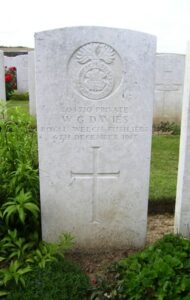
Vincent Jones Edwards, Private, 202783, Welsh Regiment. Vincent was born at Llanglydwen in 1898, the son of Thomas and Sarah Anne Edwards. The family later resided at Cilwendeg Gardens, Boncath, where Thomas and his two eldest sons, John and David, worked as Gardeners. Vincent enlisted at Carmarthen into the 9th Battalion, Welsh Regiment, which was attached to 58 Brigade, 19th (Western) Division. The Division assembled around Bulford during September 1914, and crossed to France during July 1915, moving to positions near Loos. The Division fought during the opening attack of the Battle of Loos, and then moved to the Somme, where they took part in the second wave of the attack on Ovillers-La Boiselle on 1 July 1916, capturing the village at heavy cost, and fought through the Somme Battles of Pozières and the Ancre in 1916. They then moved North to Ypres, taking part in the Battle of Messines, and fought on the Menin Road and at Polygon Wood, before moving up to Broodseinde, Poelcapelle and Passchendaele Village itself. They then spent the winter in positions south of Cambrai, which is where Vincent was sadly wounded. He died of his wounds on 27 February 1918 and is buried at Hermies Hill British Cemetery, France.
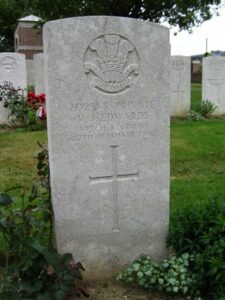
David George Evans, Private, 22840, King’s Shropshire Light Infantry. David was the son of Mrs. Ann Evans, of 3, Gloster Row, Cardigan. He lived at Glynview, Boncath prior to the war and enlisted at Pantyblaidd into the army. He was posted to France at sometime in 1916, where he joined the 6th Battalion, King’s Shropshire Light Infantry. The battalion was attached to 60 Brigade, 20th (Light) Division, and David saw his first major action with the Division during the Battle of the Somme. and took part in the advance to the Hindenburg Line in March, 1917. Later that year they fought at Third Ypres, at the Battles of Langemarck, the Menin Road, and Polygon Wood, before moving south in November, to take part in the Battle of Cambrai. They remained in the area between Cambrai and St. Quentin over the winter of 1917/18 and were attacked there by the German Spring Offensive of 21 March, 1918. They then fought in the retreat at the Battle of the Somme Crossings and the Battle of Rosieres. The Division was withdrawn after the heavy fighting of the Somme battles, moving on 20 April 1918 to an area south west of Amiens, where it rebuilt before taking part in the advance to victory from October 1918. David was killed in action soon after, being struck by a shell on 5 October 1918. He was 20 years old, and is buried at Lievin Communal Cemetery Extension, France.
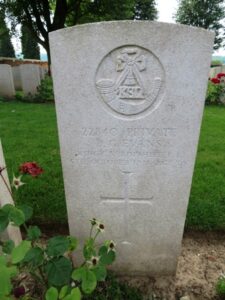
Tom Griffiths, Private, 2174, Welsh Regiment. Tom was born in 1897, the son of Daniel and Mary Ann Griffiths, of the Saddlers Arms, Cardigan. He lived at Nantyredid, Boncath prior to the war and enlisted at Cardigan into the 1/4th Battalion, Welsh Regiment, which was the local Territorial Battalion, attached to 159 Brigade, 53rd (Welsh) Division. The Division landed at Cape Helles, Gallipoli, on 9 August 1915, and was immediately thrown into action, spending the next few days in isolated pockets, fighting against a Turkish counter-attack during the Battle of Sari Bair, and then at the Attack on Scimitar Hill. Tom was killed in action here on 10 August 1915, aged 18. He has no known grave, and is commemorated on the Helles Memorial, Gallipoli.
Thomas Lewis, Private, 307317, Lancashire Fusiliers. Thomas was the son of John and Lydia Lewis, of Abercych. He worked as a wool spinner for his father, who was a wool manufacturer. Thomas married before the war and lived with his wife Margaret Jane Lewis, at Penlancych, Abercych. He enlisted at Cardiff into the army and was posted to France at some time after 1916, joining the 1/8th Battalion, Lancashire Fusiliers, which was attached to 126 Brigade, 42nd (East Lancashire) Division. The division had moved to the Western Front in February 1917, taking over the line near Épehy then Havrincourt. In September it moved north to Ypres, and fought through the Third Battle of Ypres, until moving to the Coast in September to refit. November 1917 saw the division move to positions at Givenchy, where it remained until moving back south in early 1918. Here it faced the German Spring Offensive on the Somme on 21 March 1918 and saw heavy fighting. Thomas appears to have been taken prisoner around this time. He died of wounds in captivity in Germany on 15 August 1918, aged 39 and is buried in Niederzwehren Cemetery, Germany.
Thomas Richard Lewis, Private, 37060, East Yorkshire Regiment. Thomas was the son of Jonathan and Martha Lewis, of Winilan, Boncath. He enlisted at Llanelli into the Pembroke Yeomanry, with the Service Number 5189. The Pembroke Yeomanry formed at Tenby during August 1914 as part of the South Wales Mounted Brigade, 1st Mounted Division. In 1916 they were sent to Egypt and guarded the Suez Canal Defences, but early in 1917 were disbanded, with the Battalion merging with the Glamorgan Yeomanry to form the 24th Battalion, Welsh Regiment. Surplus men were posted to other Battalions, and so Thomas joined the 1st Battalion, East Yorkshire Regiment, attached to 64 Brigade, 21st Division. In 1917 the Division was moved to Ypres, and took part in the Battle of Polygon Wood, the Battle of Broodseinde and the Second Battle of Passchendaele, before moving again, and taking part in the Battle of Cambrai. In 1918 the Division was still in the St. Quentin area when the German Offensive hit, and they took part in the Battle of St Quentin, before retreating back, and fighting at the First Battle of Bapaume. After suffering heavy casualties the Division was moved to Flanders to rest, but in April 1918 the Germans launched an offensive on the Lys. The Division was hit here, and fought at the Battle of Messines, 1918, and then the Second Battle of Kemmel. The Division was one of several that by now had become seriously weakened, and it was moved to a quiet French Sector near Soissons to rest. However, the Germans launched an offensive here, and the Division saw action again, during the Battle of the Aisne. In August, 1918 the British launched a series of offensives on the Somme, which were to ultimately lead to victory. The Division moved north, and took part in the Battle of Albert on 21 August 1918, which marked the start of the advance to victory. They then pushed east, and saw action at the Battle of Bapaume, the Battle of Épehy, and the Battle of the St Quentin Canal, which saw the mighty Hindenburg Line broken. Thomas was killed in action here on 27 September 1918. He was 27 years old, and is buried at Glageon Communal Cemetery Extension, France.
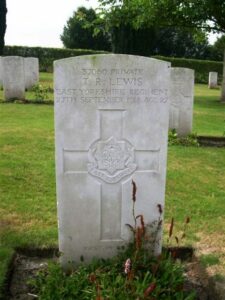
John Morgan, Corporal, 4277A, Australian Pioneers. John was the son of Jonathan and Margaret Morgan, of Yetwen, Boncath. He had emigrated to Australia to work as a miner prior to the war and enlisted at Warwick Farm, New South Wales on 6 September 1915 into the 13th Battalion, Australian Imperial Force. After training John was posted to the 54th Battalion, AIF which was being raised in Egypt early in 1916. On 4 March 1916 he was reposted to the 5th Battalion, Australian Pioneers, which was attached to the newly formed 5th Australian Division and sailed for France with the division in May 1916. John saw his first major action during the 5th Divisions attack at Fromelles on 19 July 1916, and was with the Division when it moved south to the Somme. He was obviously a brave man, as early in 1917 his Commanding Officer recommended him for the Military Medal: ‘Near Flers on the 31st October 1916 Pte Morgan was with a party detailed to dig a trench to Coy Headquarters. The site was in full view of the enemy’s lines and many casualties had already occured to officers and men crossing the open and also to parties who had previously attempted to cut this trench. Private Morgan showed great courage and endurance which inspired the remainder of the party which greatly contributed to the task being carried through-this was done under continuous shell-fire. Also near Guedecourt on the 24th Feb Pte Morgan was acting as section commander and with his men was engaged in the cutting of a communication sap from our original line to a German trench that had just been captured. Although under machine-gun and rifle fire Pte Morgan until the completion of the job did much to bring about success by his personal example to his men in which his coolness, his devotion to duty and his cheerfulness were most marked.’ Unfortunately John did not receive an award for his gallantry. He was killed in action by a shell while working at Westhoek Ridge on 12 October 1917, aged 30, and was buried on the ridge by a pillbox. His grave was never located after the war, and John is commemorated on the Ypres (Menin Gate) Memorial, Belgium.
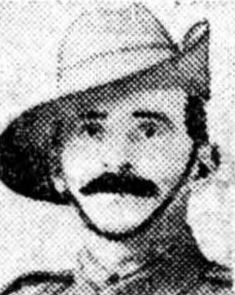
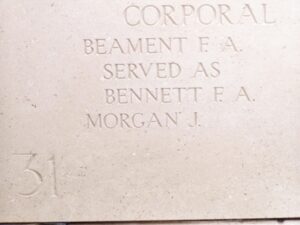
John Evan Owen, Company Sergeant Major, 12541, Welsh Regiment. John was born at Manordeifi on 30 October 1871. He was a Drapers Assistant prior to enlisting into the 1st Battalion, Welch Regiment at Cardiff on 26 September 1892. Over the next few years John had worked his way up to Sergeant, and on 12 September 1895 married Alice Maud Herbert whilst based at Pembroke Dock. By the time of the outbreak of the Boer War John was a Colour Sergeant, and he served with the 1st Welch in South Africa during the campaign, earning the Queen’s South Africa Medal with clasps Paardeburg, Driefontein, Johannesburg and Relief of Kimberley. He transferred to the Army Reserve on 10 April 1903 and on 25 September 1908 was discharged from the army. After the outbreak of the Great War John rejoined the Welsh Regiment, and was appointed Company Sergeant Major with the newly formed 8th Battalion, Welsh Regiment, which was attached to 40 Brigade, 13th (Western) Division. He died whilst in camp at Perham Down on 17 January 1915, aged 43, and is buried in Tidworth Military Cemetery, England. John is not commemorated on the memorial.
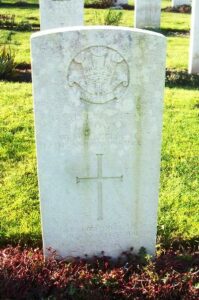
Benjamin Taylor, Sapper, 107552, Royal Engineers. Benjamin was the son of George and Sarah Ann Taylor, of Glandulais, Manordeifi. He enlisted at Fishguard into the Royal Engineers on 16 November 1915, and was posted to France on 20 November 1916, joining the 7th Field Company, Royal Engineers, which was attached to the 50th (Northumbrian) Division. During the summer of 1916 the Division was on the Somme, and fought at the Battle of Flers-Courcelette, the Battle of Morval and the Battle of Le Transloy. After spending a winter on the Somme, it moved north to Arras, and took part in the Arras Offensive of April 1917, capturing the Wancourt Ridge. It was then posted north to Ypres, fighting at the Second Battle of Passchendaele, and remained there for the winter. During March 1918 the Division was stationed near St. Quentin, and was hit by the German Spring Offensive of 21 March 1918. After taking part in a gallant rearguard action during the Actions at the Somme Crossings, the Division moved north to Flanders to rest and rebuild, but in April the Germans launched an attack in Flanders, around the Lys, and the Division saw heavy fighting again. The Division was then transferred to IX Corps, on the Aisne, believed to be a much quieter area. This was unfortunately not the case, as the Division was hit hard by a surprise enemy attack, and fought at the Battle of the Aisne, 1918. Benjamin was taken Prisoner by the Germans here on 27 May 1918. He died of exhaustion as a Prisoner of War aboard a transport train to Langensalza on 9 October 1918, aged 23. He is buried at Niederzwehren Cemetery, Germany.
Sidney David Watkins, Private, 74251, Kings Liverpool Regiment. Sidney was born at Dudley in 1898, the son of David and Jane Watkins. By 1909 the family was residing at Penraltyfelyn, Cilgerran. Sidney enlisted at Cardiff into the Army, and was posted to the 19th Battalion, King’s Liverpool Regiment, which formed at Liverpool in August 1914. On 30 April 1915 the Battalion was attached to 89 Brigade, 30th Division. The Division moved to France in November 1915, and took part in its first major action during the Somme Offensive, at the Battle of Albert, where they captured Montauban. They then fought during the latter stages of the offensive, during the Battle of Le Transloy, before wintering on the Somme. In March 1917 the Division followed the German Retreat to the Hindenburg Line, and in April took part in the First Battle of the Scarpe, and then at the later Second Battle of the Scarpe. Later that year they were moved north to Ypres, and fought at the Battle of Pilckem. Sidney must have been wounded in France, and was medically downgraded and attached to the 84th Company, Labour Corps, with his Service Number changing to 50245. Sidney was wounded whilst at Cambrai during early January 1918 and was evacuated to a Hospital near Boulogne where he died of wounds on 18 January 1918. Sidney was just 19 years old, and is buried at Wimereux Communal Cemetery, France.
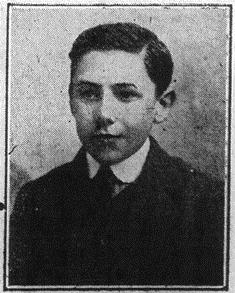
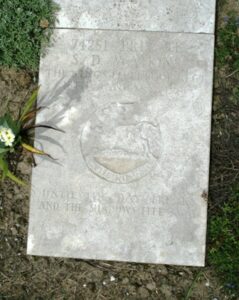
David Thomas Wooldridge, Guardsman, 24726, Grenadier Guards. David was born in 1894, the son of George and Jane Wooldridge, of Newchapel, Boncath. He enlisted at Cardigan into the Grenadier Guards, and was posted to the 3rd Battalion, which was attached to the 2nd Guards Brigade, Guards Division. This Division has the distinction of being formed in France in August 1915. The various Guards units that had been with other Divisions were withdrawn to be brought together to create this fine formation. It remained on the Western Front throughout the war and saw its first major action during the Battle of Loos on 25 September 1915, remaining in the area during the coming months, where they also fought in the subsequent Action of Hohenzollern Redoubt. In July 1916 the Division moved to the Somme, where they fought at the Battle of Flers-Courcelette, and then at the Battle of Morval, capturing Lesboeufs Village. They remained here for the winter, and in March 1917 took part in the advance caused by the German Retreat to the Hindenburg Line. Later that year they moved north to Ypres, where they fought at the Battle of the Pilckem Ridge. David was killed in action here on 31 July 1917, aged 23. He has no known grave, and is commemorated on the Ypres (Menin Gate) Memorial, Belgium.
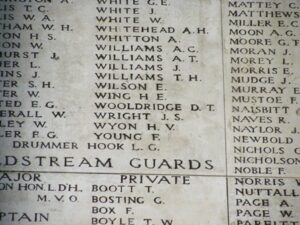
World War Two, 1939-1945
John Owen Davies, Bombardier, 799227, Royal Artillery. John was the son of Thomas and Mary Ann Davies, of Verwig, and the husband of Emily Mary Davies, of Cardigan. He was a pre-war Territorial after having enlisted in 1920. During the war he served during the war with 407 Battery, 146 (The Pembroke Yeomanry) Field Regiment, Royal Artillery. The battery served in the North African campaign, before taking part in the landings at Sicily and Salerno. It remained in Italy until after the armistice. John survived the war but died on 23 December 1946, aged 53. He is buried at Manordeifi (St. David) Churchyard. As far as is known, John is not commemorated on any war memorial locally.
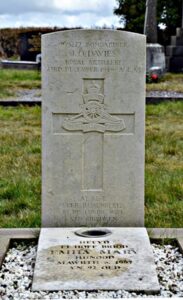
ON ACTIVE SERVICE
COL. C.J.H. SPENCE-JONES, CMG, DSO. FFYNONE PTE D.J. JONES. YETWEN.
LT. T.C. DAVIES. BRYNIORWERTH, BONCATH. PTE. D. JONES. CWM.
LT. S.P. JONES. NEWCHAPEL PTE. J.P. JONES. ABERCYCH.
LT. F. THOMAS. NEWCHAPEL. PTE. B. JAMES. ABERCYCH.
SGT. L.R. BISHOP. FFYNONE. PTE. D. LEWIS. ABERCYCH.
SGT. B. COOK. PENRALLT PTE. A. LEWIS. ABERCYCH.
SGT. G. EDWARDS. CILWENDEG LODGE. PTE. B. LEWIS. WINLLAN.
SGT. D. JONES. PARKEBACH. PTE. L.L. MORRIS. DISGWYLFA, BONCATH.
SGT. F. THOMAS. TYCOCH. PTE. J. MORRIS. ABERCYCH.
CPL. W.G. LAWLESS. GARREGWEN. PTE. J. MATHIAS. PONTRHYDYCEIRT.
CPL. W.E. MORRIS. ABERCYCH. PTE. D. MORGAN. YETWEN.
PTE. J. ALCOCK. WENRHOS. PTE. W. MORGAN. YETWEN.
PTE. R. BAUGH. NEWCHAPEL. PTE. C. NORTH. BONCATH.
PTE. E. BAUGH. NEWCHAPEL. PTE. W. OWEN. PENLANCYCH.
PTE. T. BELLAMY. PONTNEWYDD. PTE. W. PERKS. GLYNVIEW.
PTE. J. DAVIES. TYCORNEL, BONCATH. PTE. T. REES. ABERCYCH.
PTE. JAS. DAVIES, TYCORNEL, BONCATH. PTE. W.H. SALLIS. PENRALLTGOCH.
PTE. D.G. DAVIES. WENRHOS. PTE. L. SPARE. FFYNONE.
PTE. J.J. DAVIES. ABERCYCH. PTE. E. LL. THOMAS. SPRINGWELLS.
PTE. JACOB DAVIES. BONCATH. PTE. J.B. THOMAS. SPRINGWELLS.
PTE. W.G. DAVIES. FFYNONE. PTE. D.J. THOMAS. PENRALLTWEN.
PTE. J. DAVIES. GLYNVIEW. PTE. G. THOMAS. PENRALLTWEN.
PTE. A. DUNNING. ABERCYCH. PTE. J THOMAS. TYCOCH.
PTE. D.E. EDWARDS. PENTRE GARDENS. PTE. W. THOMAS. TYCOCH.
PTE. D. EVANS. TYRALLT. PTE. T. THOMAS. P.C., BONCATH.
PTE. J.W. EVANS. TYRALLT. PTE. D. THOMAS. GLANDYLAIS.
PTE. ENOS GEORGE. PENRALLTLLYN. PTE. J. THOMAS. GLANDYLAIS.
PTE. W.P. GEORGE. PENRALLTLLYN. PTE. G. THOMAS. NEWCHAPEL.
PTE. J.J. GEORGE. PENRALLTLLYN. PTE. E.G. THOMAS. ABERCYCH.
PTE. H. GEORGE. GILASTUCHAF. PTE. G. WHELE. FFYNONE.
PTE. W.D. JONES. ABERCYCH. PTE. JAS. WILLIAMS. ABERCYCH.
PTE. E. JONES. NEWCHAPEL. PTE. J. WILLIAMS. ABERCYCH.
SERVED
CPL. SID DAVIES. ABERCYCH. PTE. H. JAMES. CEFN.
PTE. E. DAVIES. ABERCYCH. PTE. J. MILLS. PONTRHYDYCEIRT.
PTE. J. DAVIES. WENRHOS. PTE. S. MILLS. PONTRHYDYCEIRT.
PTE. D.H. EVANS. CILFOWYR. PTE. J. MORRIS. ABERCYCH.
PTE. R. GRIME. FFYNONE GARDENS. PTE. D. TAYLOR. DANYRHIW.
PTE. S. GEORGE. GILASTUCHAF. PTE. T.LL. THOMAS. NEWCHAPEL.
PTE. W. JAMES. CEFN. PTE. B.H. WILLIAMS. ABERCYCH.
ERECTED BY THE PARISHIONERS
OF MANORDEIFI AND CAPEL COLMAN
IN HONOUR OF THE ABOVE HEROES
WHO FOUGHT FOR GOD, KING AND COUNTRY
IN THE GREAT WAR.
The Memorial to Major Colby
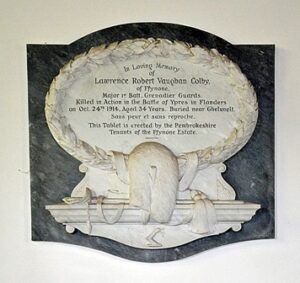
The Leaded window which commemorates Major Colby
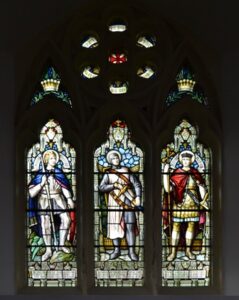
St. David’s Church, Carregwen
